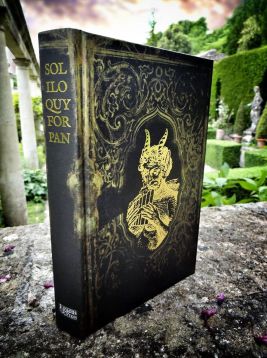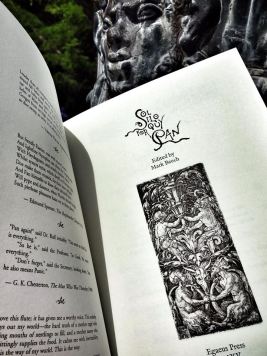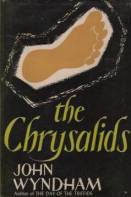
 I’m letting you all know that Soliloquy for Pan, which includes my story “The Lady in the Yard”, was released at the end of June by Egaeus Press (yes, deadlines + day job have put my bloggage behind once again). Like anything produced by Egaeus, Soliloquy is a spectacularly beautiful book – as you can see here.
I’m letting you all know that Soliloquy for Pan, which includes my story “The Lady in the Yard”, was released at the end of June by Egaeus Press (yes, deadlines + day job have put my bloggage behind once again). Like anything produced by Egaeus, Soliloquy is a spectacularly beautiful book – as you can see here.
Unfortunately, you won’t be able to buy it now. According to Egaeus, the edition has sold out entirely during pre-ordering. Editor Mark Beech however has hinted at the strong possibility of another printing in the autumn, so you can add yourself to the Egaeus email list to keep informed.
In “The Lady in the Yard”, Pan takes on female form and visits the yard of a Bronx apartment block in the early 60s. In my last post Musical Interlude 3: Farewell Ronnie Gilbert I suggested a connection between this story and the recently deceased Ronnie Gilbert of the Weavers. So here it is… “The Lady in the Yard” began as a follow-up to “She Lives in the Deep”, which appeared in The Monster Book for Girls in 2012. The Weavers are present in the narrative and provide a musical motif throughout the piece.
In “She Lives in the Deep” I wrote about Suzy, a little girl trying to lure a green and blue parakeet into her hand on a snowy day so she could take it back to her apartment and look after it. Nothing supernatural happened, and I literally left my character dangling. But in the follow-up story, the Lady in the Yard has appeared, saving Suzy’s life but not all of her toes, which she loses as a result of frostbite.
The 1960s Suzy brings a record into school by the Weavers, a lefty folk group popular in New York at the time. But teacher disapproves, saying this is a bunch of Communists. Suzy however loves the Weavers and she’s especially impressed with Ronnie Gilbert: “But all four Weavers look very friendly on that record cover, especially the fat guy. The lady wears a shiny sleeveless black dress. Her head is thrown back and her mouth is wide open to let the song out. Suzy leans her head back like the lady from the Weavers as she sings…”
With “The Lady in the Yard”, Suzy reappears in the 1970s as a pot-puffing flute-playing teenager who fervently wishes to meet the Lady in the Yard again. She’s an outcast in her high school, and escapes through reading mythology and science fiction, plus furtive late-night radio sessions listening to the likes of WBAI’s Bob Fass and Alison Steele ‘the Nightbird’ on WNEW-FM. She creates a world of her own in an abandoned swimming pool surrounded by underbrush, where she plays the flute and records on her reel-to-reel.
Perhaps the Soliloquy book resembles the old edition of Bullfinch’s Mythology that Suzy treasures. It looks like the kind of book Suzy would read it in bed while listening to her favourite late night DJs.
In “The Lady in the Yard”, I drew  on the early versions of the myth that concerned me in Helen’s Story – Pan as a shapeshifter and gender-shifter as well. Though this is the older Arcadian myth that didn’t quite find its way into the familiar classical mythology, there are still some representations of female Pan figures in Greek and Roman art. The most well-known one was found in the Villa of Mysteries in Pompeii, where a female Pan figure suckles a young goat while a male Pan figure plays an instrument.
on the early versions of the myth that concerned me in Helen’s Story – Pan as a shapeshifter and gender-shifter as well. Though this is the older Arcadian myth that didn’t quite find its way into the familiar classical mythology, there are still some representations of female Pan figures in Greek and Roman art. The most well-known one was found in the Villa of Mysteries in Pompeii, where a female Pan figure suckles a young goat while a male Pan figure plays an instrument.
Once again, Suzy doesn’t fare well when she shares her literary and musical interests. At school she gives a ‘book report’ on the post-nuclear apocalyptic classic, The Chrysalids by John Wyndham. She identifies with Sophie, a friend of the protagonist who has six toes. Sophie has to hide her extra toes so she isn’t seen as a mutated  abomination, while Suzy must hide her missing toes. After she explains the themes of this favourite book to her classmates, she is derided as ‘Mutant Sue’.
abomination, while Suzy must hide her missing toes. After she explains the themes of this favourite book to her classmates, she is derided as ‘Mutant Sue’.
The Chrysalids (or Re-Birth in the US) had certainly been a cherished book when I was in my teens. I gather it is now part of the school curriculum in the UK, but in those days it was one of the books I had to hide under my desk during lessons. I must’ve read it at least five times. My reading pleasure was heightened by the thrill of recognition when I came upon this dialogue towards the end: “Life is change, that is how it differs from the rocks… you are the crown of creation and you’ve got no place to go.” Wow! I was reading the lyrics to the Jefferson Airplane’s “Crown of Creation”.
Now, Crown of Creation was the first album I ever bought. Through my pre-teen and teenage years the Airplane was one of my top bands. Later I’d be blasting out songs like Volunteers, and listening to the likes of Sunfighter, Blows Against the Empire and Bark. Even the Airplane’s sillier songs like Have You Seen the Saucers (I did have an interest in UFOs at the time, and my favourite band singing a song about them was especially exciting) found their way onto my reel-to-reel.
So while the Weavers provided a soundtrack to “She Lives in the Deep” – along with the theme song from Diver Dan – “The Lady in the Yard” is definitely propelled by the Jefferson Airplane. And imagine my amazement when I uncovered links between these two musical inspirations: it was just like discovering the lyrics to “Crown of Creation” in a beloved book.
As I cruised about YouTube at some ridiculous hour in the night, I came across a 2008 incarnation of the Jefferson Starship singing “Drinking Gourd”, an underground railway song popularised by the Weavers in the 1950s. I found this was part of an album called Jefferson’s Tree of Liberty.
So here’s the Starship doing “Drinking Gourd” at a festival in Bedford. You might also want to check out the studio version, track at 3.38, which has an infectious boogie woogie roll to it (However, I thought the picture of the slave-owning Thomas Jefferson appearing alongside a song about the underground railroad a bit dubious, though it is the album cover.)
Much of this album is a tribute to the Weavers, covering songs like “Wasn’t that a Time”, “Drinking Gourd” and “Kisses Sweeter Than Wine” along with music from Woody Guthrie, Phil Ochs and recent compositions. The current band has a lovely way of rewriting the old songs, adapting them while keeping the spirit of the original. Starship singer Cathy Richardson ably fills the formidable shoes of Ronnie Gilbert and Grace Slick, while putting her own soulful stamp on the tunes. I stopped listening to the Starship long ago when they blanded-out with numbers like “We Built This City”, so this was a surprise and a revelation.
I found this interview with singer, guitarist and band founder Paul Kantner, where he talks about the influence of the Weavers.
“I was primarily and greatly inspired and energized by the Weavers, a folk music group from the forties and fifties that was one of Pete Seeger’s early bands. In so many ways The Weavers taught me “how to be a band”. There was a combination of beautiful three-part harmony singing and the rich folk music as well; there was also the connection to social responsibility that led to a mentality that drove our own band to the act of supporting and doing benefits for any number of people and causes in need, and then there was just the overall joy of life that shown forth from The Weavers. I treasure The Weavers still. It was for me… a memorable beginning.”
He also bigs up the Weavers in this article from Craig Morrison:
“The Weavers were my prime teachers. I sit at the feet of the Weavers, still. They were all very different people. Probably all together they make up one perfect human being, sort of like our band, Jefferson Airplane or Jefferson Starship. The Weavers and Pete Seeger particularly. What got me into music was Pete Seeger’s How to Play the 5-String Banjo book. I was a banjo player, played in college, still play banjo, love banjo. Ronnie Gilbert was the reason I wanted to work with a woman singer, just because she so obviously added a great unknown quantity that takes you far beyond even the expectations of a known. I never saw the Weavers perform, that was my one great loss, only Pete, and he was good on his own. I really wish I had seen the Weavers because they were so invigorating to my songwriting approach, to life, and to what you’re supposed to do as a band, whether you are a rock and roll band, a folk band as they were, or whatever. It’s just sort of an overall Grecian equivalent of everything you are supposed to do : good, bad, indifferent, drunken party boys to severe ascetic, almost Amish kind of Pete-Seeger-dedication to the cause.”
The Starship also has a page on its website devoted to the Weavers, and there’s more about the Weavers and their influence on the Jefferson Airplane here. Kantner does add somewhere that the Weavers themselves would’ve been horrified by the drug-taking and excesses of their late-1960s psychedelic musical descendants! But listen to the harmonies, and the way a strong female voice holds the centre in both bands. I loved the Airplane because I loved the Weavers as a child. So there you have it – Pan, the Lady in the Yard, the Weavers and the Jefferson Airplane. Have you seen the saucers? 🙂
Meanwhile, Des Lewis has written a real-time review of Soliloquy for Pan, and he says this about “The Lady in the Yard”:
‘A satisfying leisurely story… [involving] a singing wisteria, cannabis joints, flutes, Peter Pan, Panisca as the female Pan, listening to late night radio, a Lady with mutable wings, cavorting with mixed-sex naiads, Wyndham’s Chrysalids…”
I’ll end with another song from the Jefferson Airplane. Call it hippie shit, call it what you will, but I did really like this one when I were a lass. All together now!
“In nineteen hundred and seventy-five / all the people rose from the countryside / locked together hand in hand / all through this unsteady land / to move against you, government man / do you understand?”